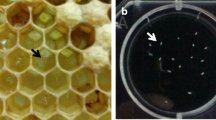Abstract
A media for the production of cell cultures from hymenopteran species such as honey bee, Apis mellifera L. (Hymenoptera: Apidae) was developed. Multiple bee cell cultures were produced when using bee larvae and pupae as starting material and modified Hert–Hunter 70 media. Cell culture systems for bees solves an impasse that has hindered efforts to isolate and screen pathogens which may be influencing or causing colony collapse disorder of bees. Multiple life stages of maturing larvae to early pupae were used to successfully establish cell cultures from the tissues of the head, thorax, and abdomen. Multiple cell types were observed which included free-floating suspensions, fibroblast-like, and epithelia-like monolayers. The final culture medium, WH2, was originally developed for hemipterans, Asian citrus psyllid, Diaphorina citri, and leafhopper, Homalodisca vitripennis cell cultures but has been shown to work for a diverse range of insect species such as bees. Bee cell cultures had various doubling times at 21–23°C ranging from 9–15 d. Deformed wing virus was detected in the primary explanted tissues, which tested negative by rt-PCR for Israeli acute paralysis virus (IAPV), Kashmir bee virus, acute bee paralysis virus, and black queen cell virus. Culture inoculation with IAPV from an isolate from Florida field samples, was detectable in cell cultures after two subcultures. Cell culture from hymenoptera species, such as bees, greatly advances the approaches available to the field of study on colony collapse disorders.


Similar content being viewed by others
References
Cox-Foster D. L.; Conlan S.; Holmes E. C.; Palacios G.; Evans J. D.; Moran N. A. et al. A metagenomic survey of microbes in honey bee colony collapse disorder. Science 318: 283–287; 2007.
Ellis J. D.; Munn P. A. The worldwide health status of honey bees. Bee World 86: 88–101; 2005.
Goodwin R. H. Insect cell culture: improved media and methods for initiating attached cell lines from the Lepidoptera. In Vitro Cell. Dev. Biol. Plant 11: 369–378; 1975.
Hunter W. B.; Katsar C. S.; Chaparro J. X. Nucleotide sequence of 3′ -end of Homalodisca coagulata virus-1. A new leafhopper-infecting virus from the glassy-winged sharpshooter. J. Insect Sci. 6.28. Online: insectscience.org/6.28/; 2006.
Hunnicutt L. E.; Hunter W. B.; Cave R. D.; Powell C. A.; Mozoruk J. J. Complete genome sequence and molecular characterization of Homalodisca coagulata virus-1, a novel virus discovered in the glassy-winged sharpshooter (Hemiptera: Cicadellidae). Virology 350: 67–78; 2006.
Kimura I. Establishment of new cell lines from leafhopper vector and inoculation of its cell monolayers with rice dwarf virus. Proc. Jpn. Acad. 60: 198–201; 1984.
Lynn D. E. Novel techniques to establish new insect cell lines. In Vitro Cell. Dev. Biol. Animal 37: 319–321; 2001.
Lynn D. E. Methods for maintaining insect cell cultures. J. Insect Sci. 2: 9; 2002.
Maori E.; Paldi N.; Shafir S.; Kalev H.; Tsur E.; Glick E.; Sela I. IAPV, a bee-affecting virus associated with colony collapse disorder can be silenced by dsRNA ingestion. Insect Mol. Biol. 18: 55–60; 2009.
Marutani-Hert M.; Hunter W. B.; Hall D. G. Establishment of Asian citrus psyllid (Diaphorina citri) primary cultures. In Vitro Cell. Dev. Biol. Animal 45: 317–320; 2009.
Mitsuhashi J. Primary culture of leafhopper embryonic tissues. J. Tissue Cult. Methods 46122: 151–154; 1976.
Mitsuhashi J. Invertebrate tissue culture methods (Springer lab manual). Springer, Tokyo-Shoseki; 2002.
Stenger D. C.; Sisterson M. S.; Krugner R.; Backus E. A.; Hunter W. B. A new phytoreovirus infecting the glassy-winged sharpshooter (Homalodisca vitripennis). Virology 386: 469–477; 2009.
Wayadande A. C.; Fletcher J. Development and use of an established cell line of the leafhopper Circulifer tenellus to characterize Spiroplasma citri–vector interactions. J. Invertebr. Pathol. 72: 126–131; 1998.
Valles S. M.; Strong C. A.; Dang P. M.; Hunter W. B.; Pereira R. M.; Oi D. H.; Shapiro A. M.; Williams D. F. A picorna-like virus from the red imported fire ant, Solenopsiskinvicta: initial discovery, genome sequence, and characterization. Virology 328: 151–157; 2004.
Acknowledgement
We thank Maria Gonzales, Biological Science Technician, USDA, ARS, Ft. Pierce, FL, for providing technical assistance.
Author information
Authors and Affiliations
Corresponding author
Additional information
Editor: J. Denry Sato
The use or mention of a trademark or proprietary product does not constitute an endorsement, guarantee, or warranty of the product by the US Department of Agriculture and does not imply its approval to the exclusion of other suitable products.
Rights and permissions
About this article
Cite this article
Hunter, W.B. Medium for development of bee cell cultures (Apis mellifera: Hymenoptera: Apidae). In Vitro Cell.Dev.Biol.-Animal 46, 83–86 (2010). https://doi.org/10.1007/s11626-009-9246-x
Received:
Accepted:
Published:
Issue Date:
DOI: https://doi.org/10.1007/s11626-009-9246-x




